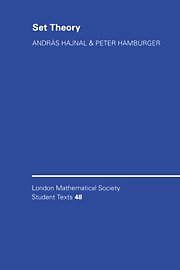Book contents
- Frontmatter
- Contents
- Preface
- Part I Introduction to set theory
- Appendix. An axiomatic development of set theory
- Introduction
- A1 The Zermelo–Fraenkel axiom system of set theory
- A2 Definition of concepts; extension of the language
- A3 A sketch of the development. Metatheorems
- A4 A sketch of the development. Definitions of simple operations and properties (continued)
- A5 A sketch of the development. Basic theorems, the introduction of ω and ℝ (continued)
- A6 The ZFC axiom system. A weakening of the Axiom of Choice. Remarks on the theorems of Sections 2–7
- A7 The role of the Axiom of Regularity
- A8 Proofs of relative consistency. The method of interpretation
- A9 Proofs of relative consistency. The method of models
- Part II Topics in combinatorial set theory
- Bibliography
- List of symbols
- Name index
- Subject index
A8 - Proofs of relative consistency. The method of interpretation
Published online by Cambridge University Press: 10 May 2010
- Frontmatter
- Contents
- Preface
- Part I Introduction to set theory
- Appendix. An axiomatic development of set theory
- Introduction
- A1 The Zermelo–Fraenkel axiom system of set theory
- A2 Definition of concepts; extension of the language
- A3 A sketch of the development. Metatheorems
- A4 A sketch of the development. Definitions of simple operations and properties (continued)
- A5 A sketch of the development. Basic theorems, the introduction of ω and ℝ (continued)
- A6 The ZFC axiom system. A weakening of the Axiom of Choice. Remarks on the theorems of Sections 2–7
- A7 The role of the Axiom of Regularity
- A8 Proofs of relative consistency. The method of interpretation
- A9 Proofs of relative consistency. The method of models
- Part II Topics in combinatorial set theory
- Bibliography
- List of symbols
- Name index
- Subject index
Summary
In the first part of the book, there were several assertions about which we said that they cannot be proved without the use of certain axioms. We now describe how a result concerning the unprovability of an assertion can be formulated precisely, and we will present two general methods that can be used to establish such results. According to the well-known Godel Incompleteness Theorem, the consistency (i.e., of the state of being contradiction free) of ZF cannot be proved inside ZF. On the other hand, it is known that, in an axiom system with sufficient expressive power, it is possible to formulate its own consistency. This formula is denoted by Con(Σ) for the axiom system Σ. As it is not possible to prove Con(ZF), it is possible to imagine a state of affairs such that one can prove, e.g., the formula 0 = 1 in ZF. For this reason we need the following definition.
Definition A8.1.Let L0 ⊂ L, Σ ⊂ Wff(L), and let φ ∈ Wff(L). We say that the formula is relatively consistent with σ if the formula Con(Σ) implies Con(Σ ∪ {φ}). The proof of such an implication is called a relative consistency proof.
- Type
- Chapter
- Information
- Set Theory , pp. 133 - 137Publisher: Cambridge University PressPrint publication year: 1999

